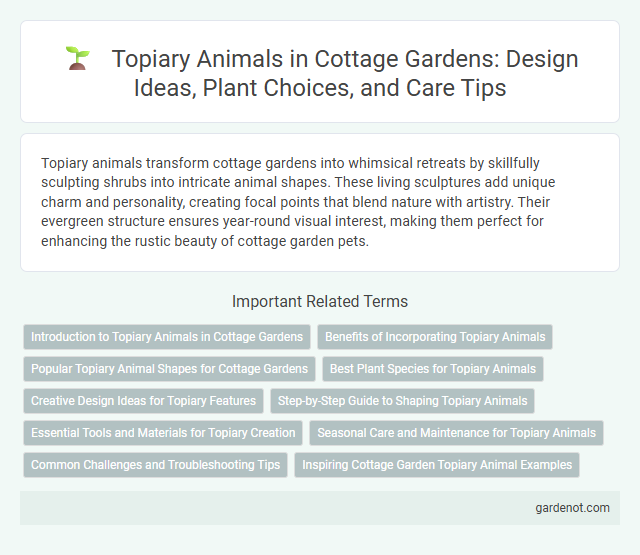Topiary animals transform cottage gardens into whimsical retreats by skillfully sculpting shrubs into intricate animal shapes. These living sculptures add unique charm and personality, creating focal points that blend nature with artistry. Their evergreen structure ensures year-round visual interest, making them perfect for enhancing the rustic beauty of cottage garden pets.
Introduction to Topiary Animals in Cottage Gardens
Topiary animals bring whimsical charm and structured greenery to cottage gardens, transforming natural spaces into living art. These sculpted plants, shaped into animals like rabbits, birds, and foxes, enhance the traditional, informal style of cottage gardens with precise botanical craftsmanship. Incorporating topiary animals adds visual interest and a playful element, blending horticultural technique with rustic garden aesthetics.
Benefits of Incorporating Topiary Animals
Incorporating topiary animals in a cottage garden enhances visual interest by introducing sculptural elements that blend art and nature, creating a whimsical focal point. These living sculptures promote biodiversity by providing habitats and shelter for pollinators and beneficial insects. Topiary animals also contribute to seasonal garden structure, adding texture and depth while requiring minimal maintenance compared to traditional flowering plants.
Popular Topiary Animal Shapes for Cottage Gardens
Popular topiary animal shapes for cottage gardens include rabbits, birds, and foxes, which add whimsical charm and enhance the natural aesthetic. These sculpted forms often use boxwood and yew, prized for their dense foliage and ease of trimming into detailed shapes. Incorporating topiary animals creates a playful, inviting atmosphere, complementing the lush, informal planting style typical of cottage gardens.
Best Plant Species for Topiary Animals
Boxwood (Buxus sempervirens) remains the top choice for topiary animals due to its dense foliage and slow growth, allowing precise shaping and long-lasting forms. Holly (Ilex crenata) offers fine-textured leaves and excellent tolerance to pruning, making it ideal for detailed and intricate animal shapes. Japanese yew (Taxus cuspidata) thrives in shaded areas and provides dark green needles perfect for creating elegant and durable topiary sculptures of animals.
Creative Design Ideas for Topiary Features
Topiary animal designs bring a whimsical charm to cottage gardens, transforming greenery into vibrant focal points that mimic birds, rabbits, or foxes with meticulous shaping techniques. Incorporating mixed plant species such as boxwood, yew, and privet enhances texture and maintains seasonal interest in these living sculptures. Creative design ideas include combining animal topiaries with flowering climbers or integrating miniature LED lights to highlight sculptural details during evening hours.
Step-by-Step Guide to Shaping Topiary Animals
Shaping topiary animals requires selecting a young, flexible shrub like boxwood or yew, then securing a sturdy wireframe in the desired animal shape. Regularly trim new growth with sharp shears, following the wireframe outline closely to maintain defined contours and encourage dense foliage. Consistent maintenance, including watering and occasional feeding with balanced fertilizer, supports robust growth and a vibrant, sculpted appearance.
Essential Tools and Materials for Topiary Creation
Essential tools for topiary animal creation in a cottage garden include sharp, precision pruning shears, wire cutters, and sturdy gardening gloves to ensure clean cuts and protect hands. Materials such as metal or wooden frames, galvanized wire mesh, sphagnum moss, and hardy fast-growing plants like boxwood or privet provide structural support and lush greenery. Using quality staples, ties, and plant ties guarantees the foliage is securely shaped and maintained for long-lasting topiary display.
Seasonal Care and Maintenance for Topiary Animals
Seasonal care for topiary animals in cottage gardens involves regular pruning to maintain their defined shapes and prevent overgrowth during spring and summer. Applying mulch around the base helps retain moisture and protects roots during colder months, while monitoring for pests ensures healthy foliage year-round. Winter protection through burlap wrapping or relocating potted topiaries reduces damage from frost and harsh weather conditions.
Common Challenges and Troubleshooting Tips
Topiary animals in a cottage garden often face common challenges such as uneven growth, pest infestations, and fungal diseases that can distort their shapes. Regular pruning using sharp shears, applying organic pest control methods like neem oil, and ensuring proper airflow around the plants help maintain their form and health. Troubleshooting poor growth involves checking soil quality, adjusting watering schedules, and removing damaged foliage promptly to promote recovery.
Inspiring Cottage Garden Topiary Animal Examples
Cottage garden topiary animals transform traditional garden spaces into whimsical and enchanting retreats, boasting meticulously sculpted shapes such as rabbits, foxes, and birds that blend seamlessly with natural surroundings. These living sculptures demonstrate exceptional craftsmanship, using boxwood, yew, and privet to achieve detailed forms that inspire gardeners globally. Iconic examples include intricate topiary swans and playful hedge hares, showcasing how to infuse character and charm into rustic, floral-filled cottage gardens.
Topiary animal Infographic

 gardenot.com
gardenot.com